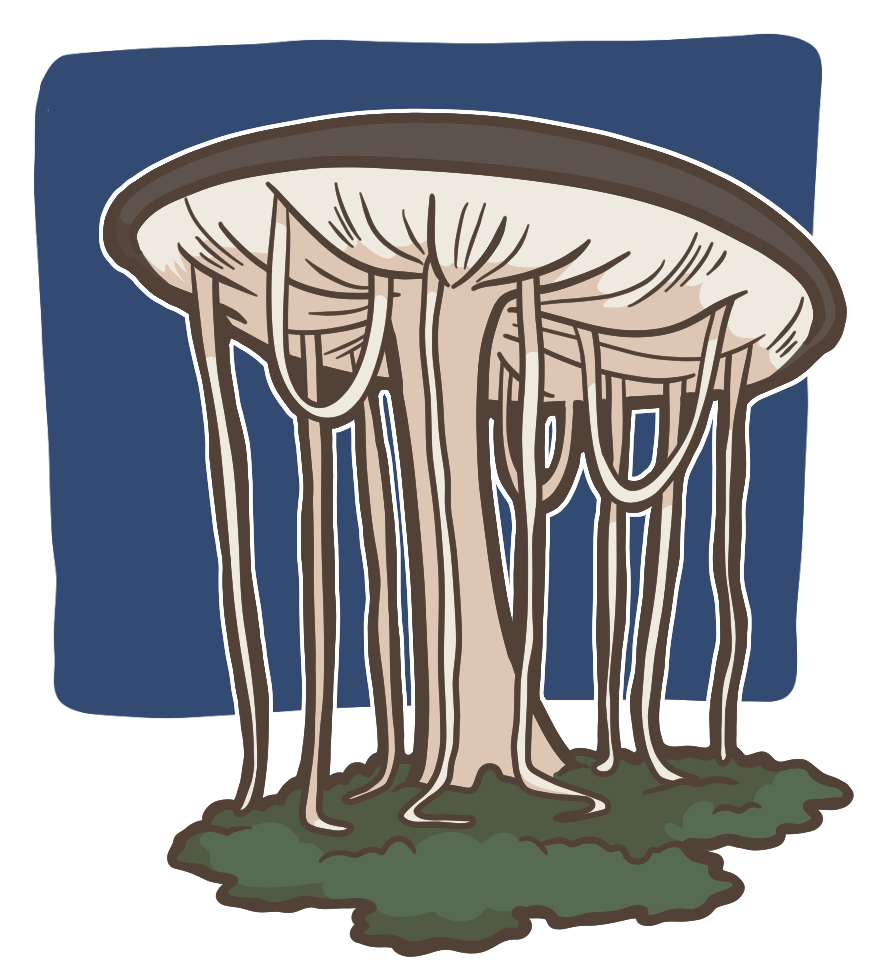Noodle Snoodle
The noodle snoodle (more simply known as the "snoodle") is a highly toxic fungus known for the strange, noodle-like filaments it produces when it spores. There are three variants of noodle snoodle, each stranger and more deadly than the last.
Basic Information
Anatomy
The noodle snoodle has a thick, wide, circular cap and a tall, sturdy stem. Their caps are usually between three and four inches in diameter. They grow no taller than four inches.
There are three variants of snoodle. The most common one is just called a noodle snoodle. The other two are known as the corkscrew snoodle and the blood snoodle.
Noodle Snoodle
The top of the cap is an unremarkable muddy color, ranging from browns to grays to faint greens. It has no patterns or markings. The gills and stem are pale cream, like the color of cooked noodles.
During spore season, strange flexible filaments descend from the gills until they touch the ground. These filaments have something to do with releasing spores, though their purpose is not fully understood. The filaments are the same creamy color as the gills and are what earn the noodle snoodle its amusing nickname.
Corkscrew Snoodle
Corkscrew snoodles look exactly the same as standard noodle snoodles when they are not sporing. They are only distinguishable during spore season, when they unfurl their filaments into a distinct corkscrew shape. The filaments of corkscrew snoodles sometimes look more like tangled hair than noodles. It is unclear why or how corkscrew snoodle filaments get their shape.
Blood Snoodle
The blood snoodle is the most easily identified of the snoodles. Its cap is much darker, sometimes pitch black. Its stem and gills are a washed-out reddish color when it is not sporing.
During spore season, the gills darken into a deep, blood red. The filaments are a bit thicker than the other variants, and often dangle just above the ground instead of resting on it. This makes the mushroom look like it is slowly oozing blood.
Blood snoodles are much rarer than normal snoodles. The reason behind their sinister appearance has been explained in folk tales, but there is no scientific explanation as of yet.
Toxicity
All variants of noodle snoodle are very poisonous. They cause acute kidney failure when consumed in high enough quantities, and are twice as dangerous when they are sporing. The filaments from noodle noodles can be harvested from the mushroom and ground into a potent poison.
Corkscrew snoodles are debatably more toxic than regular snoodles. Blood snoodles, however, are significantly more toxic than both. Only two or three blood snoodle filaments are needed to grind up a poison that could kill an adult person. Higher dosages kill faster, but the quickest time of death seems to have a minimum of about 36 hours.
Despite their deadly potential, their toxin only works if it is processed through the digestive system. The snoodles also have a very pungent taste and smell that is difficult to mask in most dishes or drinks. This makes them ill-suited for assassinations. Most poisonings by snoodles are accidental ingestions from children, pets, or those foolish enough to try to eat random mushrooms in the forest.
Ecology and Habitats
Snoodles prefer to grow in warm, damp areas, and feed on decaying plant matter. They most frequently sprout around decomposing trees in temperate rainforests. They spore when it gets very warm and wet, usually during the early and late months of summer.
Snoodles can be intentionally grown in greenhouses. They can be prompted to constantly spore if the temperature and humidity levels are very carefully controlled.




Yet another glorious snoodle joins the ranks! Very nice article, I enjoyed reading about the different varieties. =)